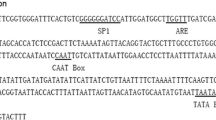Abstract
In cyanobacteria, a disruptant of hspA encoding a small heat shock protein homologue, shows decreased cell growth rates at moderately high temperatures, and loss of both basal and acquired thermo-tolerances, which resemble the phenotype of an htpG disruptant. In vitro studies have shown that both small heat shock protein and Hsp90 can bind and keep non-native proteins in a refolding-competent state under denaturing conditions. The aim of the present study is to elucidate whether constitutive expression of HspA can functionally replace HtpG, a prokaryotic homolog of Hsp90, in the cyanobacterium Synechococcus sp. PCC 7942. HspA did not improve the viability of the htpG disruptant at a lethal temperature, although it did that of the wild type. It did not improve an iron-starved phenotype of the mutant under normal growth conditions, a novel phenotype found in the present study. These results suggest that cellular function of HtpG may differ significantly from that of HspA.





Similar content being viewed by others
Literature Cited
JC Bardwell EA Craig (1989) ArticleTitleAncient heat shock gene is dispensable J Bacteriol 170 2977–2983
M Ehrnsperger S Gräber M Gaestel J Buchner (1997) ArticleTitleBinding of non-native protein to Hsp25 during heat shock creates a reservoir of folding intermediates for reactivation EMBO J 16 221–229 Occurrence Handle10.1093/emboj/16.2.221 Occurrence Handle1:CAS:528:DyaK2sXpvVSluw%3D%3D Occurrence Handle9029143
F Fang SR Barnum (2003) ArticleTitleThe heat shock gene, htpG, and thermotolerance in the cyanobacterium, Synechocystis sp. PCC 6803 Curr Microbiol 47 341–346 Occurrence Handle10.1007/s00284-002-4015-z Occurrence Handle1:CAS:528:DC%2BD3sXnslCqtbY%3D Occurrence Handle14629017
BC Freeman RI Morimoto (1996) ArticleTitleThe human cytosolic molecular chaperones hsp90, hsp70 (hsc70) and hdj-1 have distinct roles in recognition of a non-native protein and protein refolding EMBO J 15 2969–2979 Occurrence Handle1:CAS:528:DyaK28XjvFCgs7s%3D Occurrence Handle8670798
JA Guikema LA Sherman (1983) ArticleTitleOrganization and function of chlorophyll in membranes of cyanobacteria during iron starvation Plant Physiol 73 250–256 Occurrence Handle1:CAS:528:DyaL3sXlvFWqtbw%3D
MM Hossain H Nakamoto (2002) ArticleTitleHtpG plays a role in cold acclimation in cyanobacteria Curr Microbiol 44 291–296 Occurrence Handle10.1007/s00284-001-0005-9 Occurrence Handle1:CAS:528:DC%2BD38Xhs1yrurs%3D Occurrence Handle11910501
MM Hossain H Nakamoto (2003) ArticleTitleRole for the cyanobacterial HtpG in protection from oxidative stress Curr Microbiol 46 70–76 Occurrence Handle10.1007/s00284-002-3831-5 Occurrence Handle1:CAS:528:DC%2BD38XoslOqtbo%3D Occurrence Handle12432468
GJ Lee AM Roseman HR Saibil E Vierling (1997) ArticleTitleA small heat shock protein stably binds heat-denatured model substrates and can maintain a substrate in a folding-competent state EMBO J 16 659–671 Occurrence Handle1:CAS:528:DyaK2sXisV2it7c%3D Occurrence Handle9034347
H Nakamoto N Suzuki SK Roy (2000) ArticleTitleConstitutive expression of a small heat-shock protein confers cellular thermotolerance and thermal protection to the photosynthetic apparatus in cyanobacteria FEBS Lett 483 169–174 Occurrence Handle10.1016/S0014-5793(00)02097-4 Occurrence Handle1:CAS:528:DC%2BD3cXntlKjt74%3D Occurrence Handle11042275
H Nakamoto M Suzuki K Kojima (2003) ArticleTitleTargeted inactivation of the hrcA repressor gene in cyanobacteria FEBS Lett 549 57–62 Occurrence Handle10.1016/S0014-5793(03)00768-3 Occurrence Handle1:CAS:528:DC%2BD3sXmt1Gqs78%3D Occurrence Handle12914925
WJ Netzer FU Hartl (1998) ArticleTitleProtein folding in the cytosol: chaperonin-dependent and -independent mechanisms Trends Biochem Sci 23 68–73 Occurrence Handle10.1016/S0968-0004(97)01171-7 Occurrence Handle1:STN:280:DyaK1c7pvFGiug%3D%3D Occurrence Handle9538692
G Öquist (1971) ArticleTitleChanges in pigment composition and photosynthesis induced by iron-deficiency in the blue-green alga, Anacystis nidulans Physiol Plant 25 188–191
DA Parsell S Lindquist (1994) Heat Shock Proteins and Stress Tolerance RI Morimoto A Tissieres C Georgopoulos (Eds) The biology of heat shock proteins and molecular chaperones Cold Spring Harbor Laboratory Press Cold Spring, NY 457–494
R Rippka JB Deruelles M Herdman RY Stanier (1979) ArticleTitleGeneric assignments, strain histories and properties of pure cultures of cyanobacteria J Gen Microbiol 111 1–61
SK Roy T Hiyama H Nakamoto (1999) ArticleTitlePurification and characterization of the 16-kDa heat-shock-responsive protein from the thermophilic cyanobacterium Synechococcus vulcanus, which is an alpha-crystalline-related, small heat shock protein Eur J Biochem 262 406–416 Occurrence Handle10.1046/j.1432-1327.1999.00380.x Occurrence Handle1:CAS:528:DyaK1MXjvVGmtr8%3D Occurrence Handle10336625
N Tanaka H Nakamoto (1999) ArticleTitleHtpG is essential for the thermal stress management in cyanobacteria FEBS Lett 458 117–123
JG Thomas F Baneyx (1998) ArticleTitleRoles of the Escherichia coli small heat shock proteins IbpA and IbpB in thermal stress management: comparison with ClpA, ClpB, and HtpG In vivo J Bacteriol 180 5165–5172 Occurrence Handle1:CAS:528:DyaK1cXms1ehsL4%3D Occurrence Handle9748451
L Veinger S Diamant J Buchner P Goloubinoff (1998) ArticleTitleThe small heat-shock protein IbpB from Escherichia coli stabilizes stress-denatured proteins for subsequent refolding by a multichaperone network J Biol Chem 273 11032–11037 Occurrence Handle10.1074/jbc.273.18.11032 Occurrence Handle1:CAS:528:DyaK1cXjtFGktbw%3D Occurrence Handle9556585
S Versteeg A Mogk W Schumann (1999) ArticleTitleThe Bacillus subtilis htpG gene is not involved in thermal stress management Mol Gen Genet 261 582–588 Occurrence Handle10.1007/s004380051004 Occurrence Handle1:CAS:528:DyaK1MXjsFCmsLo%3D Occurrence Handle10323241
M Yonehara Y Mianmi Y Kawata J Nagai I Yahara (1996) ArticleTitleHeat-induced chaperone activity of HSP90 J Biol Chem 271 2641–2645 Occurrence Handle10.1074/jbc.271.5.2641 Occurrence Handle1:CAS:528:DyaK28XptVKrtw%3D%3D Occurrence Handle8576234
Acknowledgments
This work was supported in part by a Grant-in-aid for Scientific Research (C) (no. 16570028) from the Ministry of Education, Science, Sports and Culture of Japan to H. Nakamoto.
Author information
Authors and Affiliations
Corresponding author
Rights and permissions
About this article
Cite this article
Kojima, K., Nakamoto, H. Constitutive Expression of Small Heat Shock Protein in an htpG Disruptant of the Cyanobacterium Synechococcus sp. PCC 7942. Curr Microbiol 50, 272–276 (2005). https://doi.org/10.1007/s00284-005-4486-9
Received:
Accepted:
Published:
Issue Date:
DOI: https://doi.org/10.1007/s00284-005-4486-9




